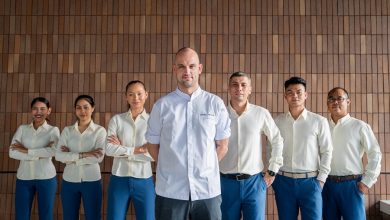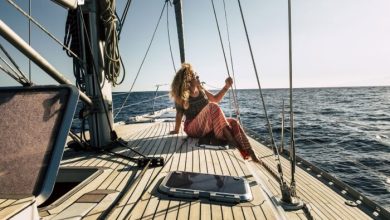MARTINIQUE MAGNIFIQUE: The time is right with new Air Canada flight

Starting Dec. 16, English Canada will at last have direct access to Martinique – previously the preserve of French Canadians (or those traveling through Montreal) alone. The Air Canada service builds on 14 years of flights from YUL and marks the first-ever flights from YYZ to the magnificent Caribbean island, which is an overseas territory of France.
Karine Roy-Camille, Deputy Director Americas for the Martinique Tourism Authority, says “the time is right” for the flights because “after the pandemic we have noticed that visitors are looking for new destinations, and new experiences, and are not only going to the southern Caribbean for the beach; they are looking for experiences and to meet with the local population – and it corresponds exactly with what Martinique has to offer.”
Pointing out that the island is “a part of France and a part of Europe,” she adds, “that means a very high standard of living, and infrastructure, safety, and security – and this is exactly what new visitors are looking for.”
Despite being a francophone favourite, Roy-Camille says the number of English Canadians visiting the island has been “so small” as to hardly be counted, but she says Air Canada’s new service will be a game changer for the tourist board in Canada, adding, “people want direct flights. Before it was a big challenge (to convince les Anglais to visit), but now we can respond exactly in terms of what they are looking for in flights and destination. But so far, they don’t know yet what Martinique is about.”
So, what is Martinique about? Travel Industry Today recently visited the island for a sneak peek ahead of the imminent Air Canada service, and here’s what we found:
Known both as The Isle of Flowers and The Rum Capital of the World, luxuriant Martinique boasts unspoiled beaches, volcanic peaks, lush rainforests, and gently crashing waterfalls, providing a contrast to its pockets of classical French architecture and luxurious villas and resorts.
Seamlessly blending modern conveniences and infrastructure with expansive green spaces, the island is recognized as a World Biosphere Reserve. And just last month, Martinique was awarded its third UNESCO recognition: for the Volcanoes and Forests of Mount Pelée and the Pitons of Northern Martinique, with the landscapes, geology and the protected endemic and irreplaceable flora and fauna of this area recognized as special by UNESCO. Yole de Martinique (a type of indigenous skiff-boat) was also listed as a UNESCO intangible cultural heritage site in 2020.
Martinique’s strong French influences are reflected in its official language and use of the Euro. Yet, the character of Martinique is distinctly its own: the island’s musical heritage, art, culture, and cuisine proudly honour its Creole roots.
Fort-de-France, the island’s vibrant capital, showcases the dichotomy: colourful dwellings mingle with sprawling gardens and stoic French cathedrals along the crescent of a scenic bay.

Quebec
As for Quebecois, Roy-Camille says Martinique is not an unknown destination, noting that the tourist board has had an office in the province since 2008 and has worked closely with travel agents and supplier partners like Air Canada and Club Med, as well as Atout France.
She adds the ratio of repeat visitors from Quebec is very high, with the average being 10-12 days (longer than most other markets) and spend higher even than tourists from France.
With the same language, she adds most Quebecois are extremely confident in the destination and often rent houses or Airbnbs, rent cars to go out and about, and often make friends that they will come back to visit.
All of this adds up to Canada being Martinique’s second market, after France, but ahead of the US.
Toronto
Now with new Air Canada service set to take flight, Roy-Camille says the tourist board will extend its focus to the English Canadian market – specifically Toronto – with the initial goal being to ensure that the weekly winter flight is successful before looking to year-round service. “The challenge is first to give awareness about the destination,” she says.
For agents, that includes conducting FAM trips and participating in trade shows, including its own dedicated event in November.
“We do consider travel agents very important because they can give and share the right information about Martinique, because they cannot promote or sell Martinique like the other Caribbean islands… Maybe you think you know Caribbean islands, but Martinique will surprise you.”
France
Roy-Camille says that while Martinique is located in the heart of the Caribbean, being part of France makes it a totally different experience. “We are Creole, but we are a mix of cultures, coming from Africa and India and influenced by France. And as we do speak French, it is a different culture and heritage.”
She adds, “We enjoy spending time with our visitors – we don’t call them tourists. They arrive as visitors and leave as part of our family. And we like to share things – our festivals, dinner – we are very generous, and we like to please people. This is really in our DNA.”
Accommodation

Roy-Camille says it is important to know that there is only one all-inclusive on the island – Club Med Buccaneer’s Creek – “a fantastic property in a fantastic location.” The property is undergoing extensive renovations highlighting significant changes to the rooms, reception area, main restaurant, with the first phase to be complete when the resort reopens later this fall. The refresh will include all-new interiors organically inspired by the vibrant colours of the surrounding nature and rich Creole culture.
But there are multiple other options, such as small boutique hotels, mid sized properties with 82-100 rooms, a few bigger hotels, but also a multitude of villa rental properties from two bedrooms to full concierge service with chefs and “any type of service you could imagine.”
Two Travel Industry Today recommended hotels include five-star La Suite Villa Hotel & Spa, a nine-villa and six-suite boutique property with sea-views and outdoor restaurant serving French and Creole cuisine. It’s located in Les Trois-Islets, a short local ferry ride from Fort au France; and Diamant les Bains, Martinique’s first hotel in 1945, and now a completely renovated four-star property overlooking the landmark Le Diamant (rock), and studio rooms, bungalows, a restaurant, pool and direct access to the beach.
And brand new is Sable Bleu in Le Marin’s Bay, a rare multi-storey building (and first in Le Marin) with rooftop bar and plunge pool overlooking Martinique’s primary marina, and across the harbour from Club Med. The four-star hotel features 16 sleek and elegant rooms, high on technology and sustainability. Yachters, coming and going from Martinque are expected to be prime clientele.
For villas rentals, Villa Veo boasts about 135 units around the island, accommodating from two to 14 people. A pan-West Indies company ensures consistency and quality control, with units ideal for groups and special occasions, like weddings, that are generally priced less than hotels. Most people stay a week. Additional services like chefs, massage, and rum masterclasses can be arranged. Units have pools and are located in quiet places, and include concierge services and English-speaking staff.
Cruise
Cruising is also big business in Martinique with most of the major cruise lines represented, reflecting the island’s position as an important cruise hub in the Caribbean. “We’re a huge cruise destination,” says Roy-Camille.
MSC Cruises, which offers fly and cruise packages to the island, also homeports in Martinique, along with Costa, Ponant, and Club Med. With MSC, visitors can combine seven- and 14-day southern and northern Caribbean itineraries with a one week stay in Martinique.
More than the beach
While Martinique has its share of spectacular beaches, Roy Camille acknowledges there are many beaches all around the Caribbean – but she emphasizes, “If you’re looking for an eco-friendly destination, this is Martinique. If you’re looking for hiking, or trails, for kayaking, or to learn how to protect the mangrove, this is the place to come.”
Diving, with more than a dozen sites – including the shipwrecks of Saint-Pierre – is also a popular pastime, and bustling Fort-de-France boasts a historic fort (tours must be arranged), cathedral, colourful covered food and crafts market, La Savene des Esclaves slave (and indigenous peoples) museum, and European-style shopping.
A boon for the island no doubt is its third UNESCO designation – recognition that attracts a lot of visitors, Roy-Camille says, adding, “you can double the number of visitors.” With this in mind, the capital Fort au France will see a new airport terminal open in November.
Meanwhile, much of Martinque’s natural attributes are on display in the mountainous north, prompting Roy-Camille to state while most visitors stay in the south, “you have to go to the north,” which she calls a green “island within an island.”
On the way is Le Domaine d’Emeraude, a 24-hectare nature park that has four kilometres of trails through the heart of the lush rainforest, featuring some of the island’s 3,600 trees and 100 indigenous species. There is also a botanical garden, arboretum, and interactive pavilion, the latter detailing the island’s Acadian heritage (more than 12,000 arrived in the mid 1760s, including many exiles from Canada).
Meanwhile, Habitation Ceron is an idyllic setting at the north tip of the island. The former plantation site (still lived in and family-run) notably features the sprawling, approximately 300-year-old Zamana tree, which is the believed to be the biggest tree in the Caribbean and has been voted the most beautiful in France. The site has marked trails, a stream for swimming (well, dipping), a restaurant, and offers horse riding,
Of course, beaches on the island have an immeasurable allure and can be accessed directly or via ubiquitous beach bars and beach-side restaurants, many of which provide lounges and, in some cases, other facilities (such as change rooms), as well and food and drink for guests. A great example of the former is Bao Beach at Pointe Marin, while Le Petitbonum beach bar comes alive at sunset with live music and libations.
Culinary
A highlight of any visit to Martinique is its food, a Creole cuisine that is a mix of African, Indian, Caribbean, and French influence. And naturally, very colourful, plentiful seafood. On the way north, stop for lunch at La Chaudiere Morne Rouge for a tasty Creole sampling.
There are over 365 restaurants island-wide cover all the gastronomic bases, prompting Roy-Camille to laugh, “Nobody ever left Martinique without saying, ‘I had a great culinary experience.’”
Rum

Martinique is also known for its rum, namely the unique ‘Rhum Blanc,’ a legacy spirit still made from sugarcane (not molasses) by 12 distilleries linked by a touristic “rum trail” where visitors can discover the art of rum production through guided tours, and, of course, tastings.
At historic Trois Rivieres, visitors can also hop on an ATV for an incredible hour-long off-road guided tour (which can be booked separately) through the cane fields on the distillery’s vast estate, also showcasing Martinique’s coastline and Le Diamant.
Notably, Martinique has joined the rank rum royalty through numerous awards, including the prestigious AOC (Appellation d’Origine Contrôlée) designation, which recognizes the unique production of a spirit that is considered lighter and cleaner tasting than modern rums.
Not surprisingly the national drink is the rum-based Ti’punch, a cocktail made with Rhum Blanc or Rhum Agricole, complemented with a hint of lime and cane syrup.
Getting there
Weekly Air Canada flights from Toronto will operate weekly for the winter starting Dec. 16. The route, which is the culmination of a long-term effort and vision advocated by the Tourism Commissioner Bénédicte di Géronimo, will take five hours between YYZ and Fort-de-France, utilizing Airbus A220 aircraft with a capacity of 137 seats. Air Canada says it has optimized other routes to conveniently feed into the service.
Getting around
With good roads and easy-to-get rental vehicles, Martinique is ideal for exploring, and with English widely spoken, Roy-Camille assures, “you’ll never get lost here.”
But exploration by water should be mandatory – to the see the “blue island” (as opposed to the green island), not least on the ubiquitous fun catamaran tours that include food and drinks, plus stops for snorkelling or visiting a pretty seaside village.
Sailboats can be rented for longer durations, while fishing and diving and kite surfing excursions also present other offshore options.
Travel agents
The Martinique tourist board is eager to work with travel advisors, who can reach out to the office for information and collateral material (in English and French), and for contacts on-island. There is also specialist program for agents tailored to a Canadian audience (not US). For information, email information@lamartinique.ca; website – us.martinique.org/.
On Nov. 7, a delegation from the island, including tourism minister Benedicte de Geronimo, will visit Toronto for a trade event to celebrate the launch of the Air Canada Toronto flight.
All of which leads to Roy-Camille to exude confidence that English Canadians will soon discover her “Caribbean jewel.” But she’s taking nothing for granted. “We want to exceed expectations,” she says. “You want to do that? (e.g. hiking), okay, you can do that. But then you will find many, many other (aspects) of Martinque to enjoy.”
First published at Travel Industry Today





